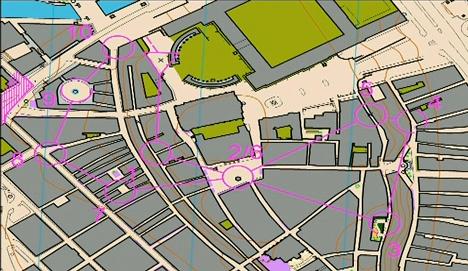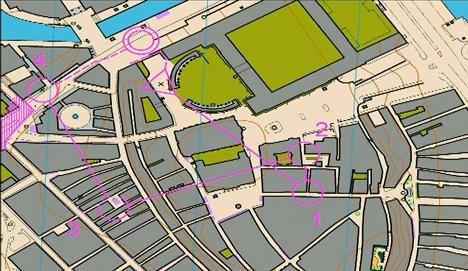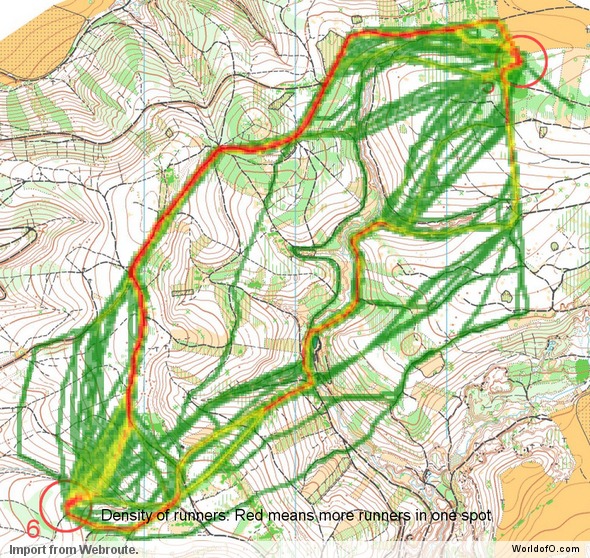
Fabien Hertner and Helena Jansson won todays KnockOut-sprint at the Nordic Orienteering Tour after big mistakes by favorites Simone Niggli and Daniel Hubmann made in the finals. Hertner was in the lead all the way from the start in both the semifinal and the final – and nobody was even close in the end. In the womens class, Simone Niggli had the lead for most of the final, but a big mistake in the end of the course cost her the top position – and in the end she was only 5th.
Hertner was really satisfied after his big win today.- It was really great. The terrain was really perfect for this. I was a little bit afraid that it was only running and following each other, but there were really routechoices. I know that if I took just a 5 seconds slower routechoice, they would be here again. So I was very careful with the routechoices, and pushed as hard as I could.
Courses
The courses were typical shortened urban sprint courses with several routechoice options on some of the legs (see map with first loop in the finals above and second loop below- screenshot from TV broadcast on orientering.se). From watching the TV broadcast, it looked like the runners were mostly following each other – the tactics for the one behind being to wait for a mistake from the one in front. It will be interesting to hear the opinons of more runners than the winner Hertner.

Results
Men
1. Fabian Hertner (SUI)
2. Jerker Jysell (SWE)
3. Francois Gonon (FRA)
4. Øystein Kvaal Østerbø (NOR)
5. Graham Gristwood (GBR)
6. Daniel Hubmann (SUI)
Women
1. Helena Jansson (SWE)
2. Beata Falk (SWE)
3. Galina Vinogradova (RUS)
4. Maja Alm (DEN)
5. Simone Niggli (SUI)
6. Elise Egseth (NOR)
Orienteering format of the future?
The TV broadcast was fun to watch, but the cameras were on the runners for significantly less than half of the time. What do you think of the race format and the TV broadcast?
 World of O News
World of O News

I was not impresst. After that much work with all the other things, the planing for the cameramen could have done much better with only two more. The only thing wich is interesting is the route choise. That must be shone.
For me as a runner such a format would be very boring.
For me as a spectator it may be much much interesting. The great favorites made mistakes — I want to see these mistakes! It should be some kind of GPS information (GPS would not work in current technical level, but maybe some alternative technology). As well, I want to have not only 3 cameras, but on every control. And I want to see online tracking and video simultaneously on the screen. Then it can be admissible. And, of course, operators must be more experienced in O and more instructed.
I agree with both of you. Cameras didn’t work the way they were set up ; we didn’t really see any of the action. Regarding GPS-information, the problem is the location. I think I would have rather organized this type of event in a park / city forest where there is proper GPS coverage (and thus it would be possible to use GPS technology). Also, I would have had some sort of forking. I think that two very short sets of butterflies with tricky orienteering would have made it more interesting for the runners, and not much more difficult to follow for the viewers.
Regarding the current production, the way they showed the map (static – always zoomed all the way out to see all of the course) really didn’t work at all. One step better would be to zoom in and only show the leg they were just running (no technical effort at all to set up). Another step would be to show an animation of the possible route choices on the current leg (not GPS tracking, but only animation of the route choices). Also little technical effort to set up, but would have made the production less static. I guess the reason was that this was a low-cost production, but I can’t imagine that the cost for showing the map in a better way would be much compared to the cost of the complete production.
That said, it was still exciting to watch – and as an orienteer I liked the broadcast – and the knockout sprint concept worked better in showing what was happening than stage 1 of NORT. However, the main problem for “real TV” in my opinion was that it was very static.
The weak point to me was, that you didn’t really see the decisive moments.
@Otherswiss: Yeah – that was probably the biggest problem. What did really happen to Simone & Daniel? They’ll probably answer in their webpage some time soon..
In such short event viewers should have information about competitors every second. It was quite boring to watch tourists on the streets of Stockholm.
When Simone lost her leading position there was no information about what happened with her. It make our sport tricky and incomprehensible for ‘normal’ viewers.
Most is said already. Some additional comments:
It was nice to see orienteering on TV, both in Finland and in Sweden. Hopefully it got good audience over there. The NORT webpage however is very unprofessional. For todays 4 rounds, online results would have been desirable, or at least quicker uploading of the result lists.
Personally, I liked the static full map. It is easier for non-orienteers to comprehend. Zooming around control by control would be too confusing. Instead, drawing the different route choices for the actual control would good enough, and easy to implement. The speaker then could comment on who is taking which route.
During the short interview, Simone Niggli mentioned that when she approached the second last control (no. 3, coming on the Southern route), she entered one alley early and thus finding herself on Southern of the two little plazas.
What I disliked most, was Jerker’s nose picking when he was introduced to the spectators. Was that supposed to be cool? He screwed it :~)
the main problem was that there was no tracking. if there was some tracking it would be more easy for the commentators to comment and us to watch, what also lacks were the cameras, too few of them, there could be 3-4 cameras more. the map animation could be better as jan already said, it would be advisable to adjust the map so that the coming legs are turned in a way a runner would turn them, so that the spectators could get the better feeling of whats coming next. what i really liked was the introduction to runners, although the commentators could learn more about the runners and tell some major success to each one of them they deserve to be treated like stars after all those training sessions.
Imagine the TV-screen showing the runners live at “every” moment of the course (at least the decesive moments), with the map in its own part of the screen, showing the actual leg with every runner’s accurate position and routechoise. Showing best routechoice, showing split times at every control compared to best times, heart rates, …
This concept has huge potensial!
Accurate positioning system? Take a look at this: http://www.slashgear.com/invisitrack-launch-super-accurate-gps-alternative-2478972/
For me as a spectator the broadcast was very boring. What about including also mobile cameras (eg on motorbike) which follow the runners? This could bring some action…